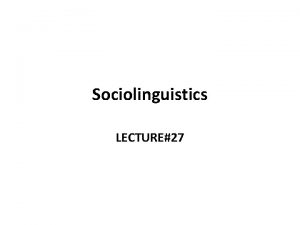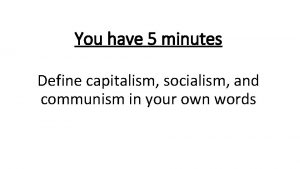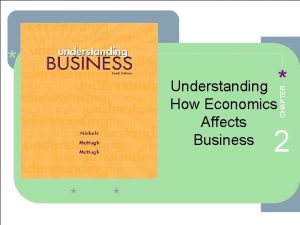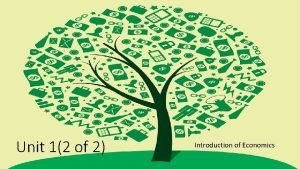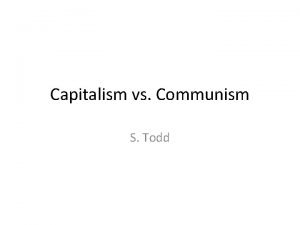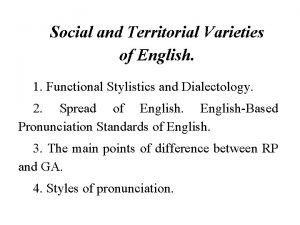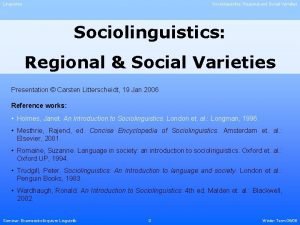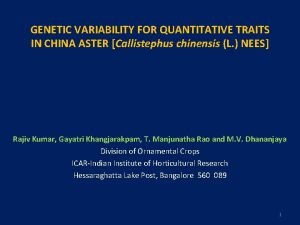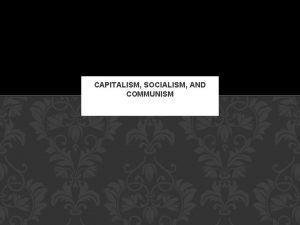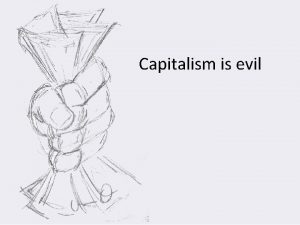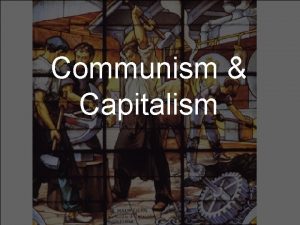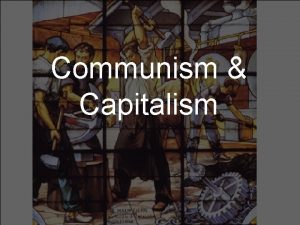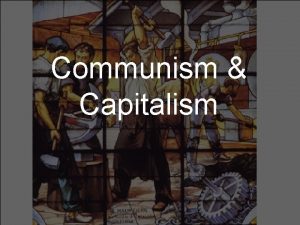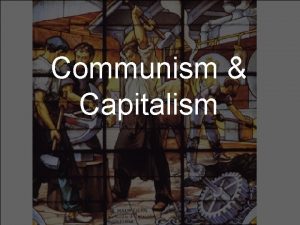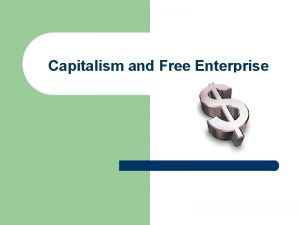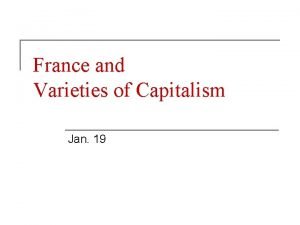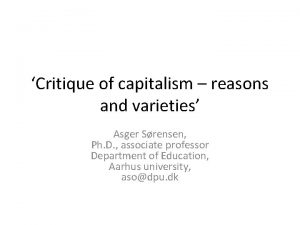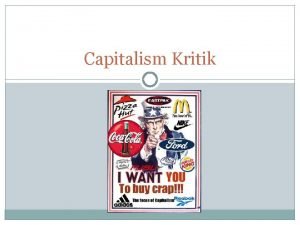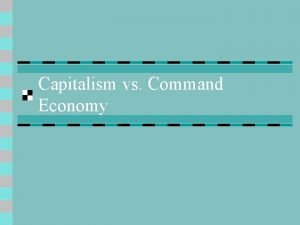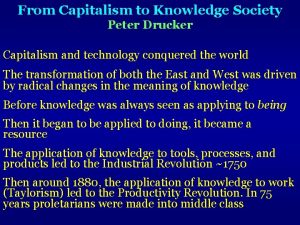Varieties of capitalism Vo C and Varieties of
































- Slides: 32

Varieties of capitalism (Vo. C) and Varieties of distributions (Vo. D): How welfare regimes affect the preand post- transfer shapes of inequalities? LOUIS CHAUVEL AND EYAL BAR-HAIM UNIVERSITY OF LUXEMBOURG, PEARL INSTITUTE FOR RESEARCH ON SOCIO-ECONOMIC INEQUALITY (IRSEI) 1

Outline Background ◦ Many shapes of inequality: Varieties of distributions (Vo. D) ◦ Models of redistribution (pre and post tax and transfer distributions) Method ◦ ISOgraph a new way to detect Level-specific inequalities ◦ LIS data implementation Results ◦ Cluster analysis & welfare regime typology (Kammer et al 2012, Schroeder 2013) ◦ Comparison with Gini better understanding of effects of redistribution ◦ Differences in Level-specific inequalities : pre, post and difference 2

Varieties of welfare capitalism and redistribution logics Inequalities among different levels of the distribution Welfare transfers can be allocated in various methods, affecting different levels of income unevenly ◦ Intensity of redistribution ◦ Targeting of redistribution ◦ Shapes of inequalities The resources for these transfers can be obtained from various income categories– from the upper level to the median category (and even lower income groups) 3

Theories of Welfare Regimes Decommodification models and welfare regimes “De-commodification occurs when a service is rendered as a matter of right, and when a person can maintain a livelihood without reliance on the market” (Esping-Andersen, 1990, pp. 21 -22) Gosta Esping-Andersen (Danish, born 1947) Professor @ Universitat Pompeu Fabra (Barcelona). 4

Gösta Esping-Andersen GEA first typology: 5 Liberal (=Residual) Corporatist (=Conservative) Social-demo. (=Universalistic) Degree / Model of decommodification Free Market as the central institution Intermediate level of decommodification The level of decommodification is maximal System of social stratification Protection of the (good) poor, but stigmatization of “free riders”: Strong economic inequalities but more permeable boundaries between social classes Typical countries US UK Solidarity between Strong collective equals: consumption: Intermediate degree economic inequality of inequality but is minimal and social boundaries strong “fluidity” strongly (net mobility, impermeable equality of opportunities) between classes Germany (France) Sweden

Welfare regimes typology Schröder, M. (2013). Integrating varieties of capitalism and welfare state research: A unified typology of capitalisms. Springer. 6

Redistribution Change economic inequality Using tax and transfers We consider Before (Market), After (Final), and Difference (Effort ) Pigou-Dalton transfers – taking from the relatively rich and giving to the relatively poor reduce inequality The reality can be more cynical than PD thought: the (upper) middle can take the money (from the rich) and run More than a simple Gini (Kenworthy & Pontusson, 2005) 7

ISOGRAPH X = logit of the fractional rank r (=logitrank) of resource (income, wealth, etc. ) [r between 0 and 1] Y = log medianized resource (resource divided by its median) ISO=Y/X is a measure of Level-specific inequalities If ISO=a (constant) Champernowne-Fisk (double Pareto) distribution with a = Gini (Dagum, 1977) 8

ISOGRAPH Reading the ISOGRAPH (Chauvel, 2016; Chauvel & Bar-Haim, 2017) ◦ Each point represent ISO at the X (specific-level inequality) ◦ Differences in ISO at X level indicate variation in inequality levels The higher ISO, the higher the inequality at this specific level (=stronger stretch of the distribution) 9

DATA & HARMONIZATION To study the impact of different tax and transfer policies on inequality LIS datasets (183 datasets with before/after) – 36 countries, 1967 to 2013 We consider “level of living” = equivalized DHI – disposable household income per standard adult Pre- and post- tax & transfer ◦ We added income taxes and social contributions for household (per standard adult) ◦ We deduct transfer income for household (per standard adult) Select between age 25 & age 55 (reduce pensioners issues/ see later) adults at labour-participation age 10

DATA & HARMONIZATION First, we will look at the raw data for only 4 countries ◦ http: //www. louischauvel. org/lissy 4 countries. txt ◦ Run on the LISSY… Next, the complete dataset can be analyzed using: ◦ http: //www. louischauvel. org/vocvod 183. do 11

ISOGRAPH X = Logit rank of disposable Income [aggregated in 9 categories ci={-3 to 3}] We compare 3 shapes of distributions: ◦ ISO 3 pertains to equivalized disposable income = “level of living” = POSTRANSFER Y 3 = (Log medianized disposable income) ISO 3 = Y 3 / X ◦ ISO 1 pertains to income before taxes and transfers = PRETRANSFER (“initial income” = labor + capital) ISO 1 = (Log medianized initial income by ci group)) / X ; ◦ ISO 2 pertains to the difference (“effort”) ISO 2 = ISO 1 – ISO 3 12

LIS examples of ISO of pre- and post transfers + effort post transfer pre transfer effort 13

post transfer pre transfer effort “Some” targeting Low intensity of redistribution 14

Clustering Before after and the differences (ISO 1 ISO 2 ISO 3 ) Mean ISO in each part of the income distribution for all the observations of a country after 2000 PCA on before after and the differences Cluster by the components produced by PCA Robustness ◦ ◦ Direct clustering (without PCA) Only before and after (without the diff) Only one time point (the last one for each country) Including non-western countries Basically keeps the same cluster, with minor differences in specific countries 15

Cluster analysis (statistical aspect) ◦ How to group individuals / countries in homogeneous groups, different one each other, on the base of proximity on different indicators / criteria? ◦ General solution: cluster analysis ◦ We need: -set of individuals (countries) -set of indicators/variables* describing them * “standardized” variables = mean equal zero, standard deviation equal one 16

Cluster analysis (statistical aspect) ◦ There is an infinite number of strategies for clustering ◦ The most standardized: Hierarchical cluster analysis, Ward’s method Wage Education 17

Cluster analysis (statistical aspect) We have the cloud of individuals (N) ◦ We detect the closest couple of individuals (here 1 and 2) ◦ We aggregate (1) and (2) in a single, new fictitious individual (a) of weight =2 ◦ We compute an indicator I (inertia) of information lost in the aggregation ◦ Go back to first step until all the points are aggregated Wage Education 18

Cluster Analysis for Isographs (initial inequality, disposable income inequality and the Redistribution Effort) post 2000 cluster ward yyy*, name(clav 0) cluster generate g 2 = groups(2), name(clav 0) cluster dendrogram clav 0, vert labels(is) scale(. 6) 19

Theories of Welfare Regimes Decommodification models and welfare regimes “De-commodification occurs when a service is rendered as a matter of right, and when a person can maintain a livelihood without reliance on the market” (Esping-Andersen, 1990, pp. 21 -22) Gosta Esping-Andersen (Danish, born 1947) Professor @ Universitat Pompeu Fabra (Barcelona). 20

Gösta Esping-Andersen GEA first typology: 21 Liberal (=Residual) Corporatist (=Conservative) Social-demo. (=Universalistic) Degree / Model of decommodification Free Market as the central institution Intermediate level of decommodification The level of decommodification is maximal System of social stratification Protection of the (good) poor, but stigmatization of “free riders”: Strong economic inequalities but more permeable boundaries between social classes Typical countries US UK Solidarity between Strong collective equals: consumption: Intermediate degree economic inequality of inequality but is minimal and social boundaries strong “fluidity” strongly (net mobility, impermeable equality of opportunities) between classes Germany (France) Sweden

Welfare regimes typology Schröder, M. (2013). Integrating varieties of capitalism and welfare state research: A unified typology of capitalisms. Springer. 22

Cluster Analysis for Isographs (initial inequality, disposable income inequality and the Redistribution Effort) post 2000 Corporatist Social-Democrat Liberal Christian Conservative 23

Local inequalities before redistribution, after redistribution and in the effort (difference) pre transfer post transfer ISO effort Corporatist and Social-Democratic countries, achieve a relative flat line after redistribution. However, Level specific inequalities below the median income is higher in SD countries. Liberal countries start with high level of overall inequality and high specific level inequalities, especially below the median income. level specific inequalities among the poorest are much lower after tax and transfers. Christian Conservative countries have very little differences between inequalities before and after tax and transfers. X=logit(quantile) 24

Social logics of Distributional-regimes Neo-Liberal distribution regime: The victims of market incomes benefit from targeted programs (excluding the median from redistributive gains) but inequality/poverty after redistribution are still high. The end result is not only high overall level of inequality, but also more specific-level inequalities for the groups who are near the median income. 25

Social logics of Distributional-regimes Corporatist distribution regime: A considerable part of the redistribution efforts of these countries are based on labour market efforts (regulation and collective bargaining). Levelspecific inequalities before redistribution below the median income are low. The end result is relatively low inequality. 26

Social logics of Distributional-regimes Social-Democratic distribution regime: even tough some effort is made before tax and transfers, much of the investment in redistribution effort to reduce inequality is based on tax and transfers (“flexicurity”). The end result is much more evident at the lower parts of distribution. 27

Social logics of Distributional-regimes Conservative Christian distribution regime: Minimal tax and transfers based redistribution. Family and community arrangements prevent strong “market” inequalities. The overall inequality is similar to the Neo-Liberal regime, in a context where redistributions have almost no role in income equalization. 28

Local inequalities before redistribution, after redistribution and in the effort (difference) ISO Corporatist and Social-Democratic countries, achieve a relative flat line after redistribution. However, Level specific inequalities below the median income is higher in SD countries. Liberal countries start with high level of overall inequality and high specific level inequalities, especially below the median income. level specific inequalities among the poorest are much lower after tax and transfers. Christian Conservative countries have very little differences between inequalities before and after tax and transfers. X=logit(quantile) Dashed = before 1995 Bold = post 2000 29

The Nordic shift See Marx, I. , Salanauskaite, L. and Verbist, G. (2013) The Paradox of Redistribution Revisited: And That It May Rest in Peace? , Discussion Paper, IZA. • The most important result is the progressive shift of the Nordic regime from labour-market based equalitarianism in the 1980 s to a new shape of distribution where massively means tested redistributions rebalance massive potential poverty at the bottom of income distribution. • This shift can become a real challenge and source of social stress. • This trend looks more general than specific to Nordic countries. 30

Conclusions • Different welfare regimes lead to different strategies of distribution and redistribution to reduce inequality • The effects of different redistribution strategies are evident on level of overall inequality, but also on the “local” inequality (the gaps between different parts of the income distribution) • Redistribution regimes are not stable over the years. The changes can be traced better when considering the “local inequalities. 31

Thank you! VARIETIES OF CAPITALISM (VOC) AND VARIETIES OF DISTRIBUTIONS (VOD): HOW WELFARE REGIMES AFFECT THE PRE- AND POSTTRANSFER SHAPES OF INEQUALITIES? 32
 Fin fish market forms
Fin fish market forms Bell's seven criteria for language
Bell's seven criteria for language What is standard variety of language
What is standard variety of language Linguistic varieties and multilingual nations
Linguistic varieties and multilingual nations Language dialect and varieties in sociolinguistics
Language dialect and varieties in sociolinguistics Communism and capitalism dbq answer key
Communism and capitalism dbq answer key Capitalism pros and cons
Capitalism pros and cons Capitalism pros and cons
Capitalism pros and cons Socialism and capitalism in an inspector calls bbc bitesize
Socialism and capitalism in an inspector calls bbc bitesize Pros and cons of capitalism
Pros and cons of capitalism Communism is better than capitalism pros and cons
Communism is better than capitalism pros and cons Chapter 6 varieties of drama
Chapter 6 varieties of drama Territorial varieties of english pronunciation
Territorial varieties of english pronunciation Ismail varieties store
Ismail varieties store Rice photos
Rice photos Drosera capensis varieties
Drosera capensis varieties Varieties of drama
Varieties of drama Variety refers to
Variety refers to Varieties of culture
Varieties of culture A merchant mixes three varieties of rice costing
A merchant mixes three varieties of rice costing Suspension therapy is which type of exercise
Suspension therapy is which type of exercise Types of project termination
Types of project termination This ameba would most likely be classified as a
This ameba would most likely be classified as a Sociolinguistic competence example
Sociolinguistic competence example Indigenized dialect
Indigenized dialect Iihr china aster varieties
Iihr china aster varieties Language
Language When apple growers talk about new varieties
When apple growers talk about new varieties Chapter 8 varieties of american nationalism
Chapter 8 varieties of american nationalism Mercantilism vs capitalism
Mercantilism vs capitalism Who created this
Who created this Characteristics of capitalism
Characteristics of capitalism Reviewing key terms
Reviewing key terms

